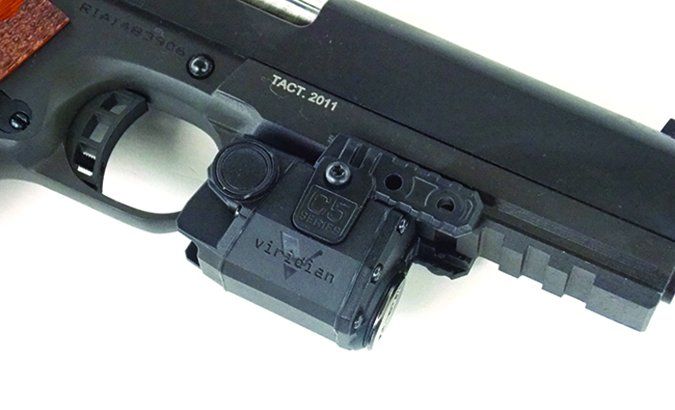
Guns fitted with accessory rails, aka rail guns, are a popular choice for both self defense and home defense because of their ability to mount a combat light or advanced laser. These are nice features to have on a defense handgun, but they must be paired with features that make a difference to accuracy, reliability, and handling, such as a speed safety and a well-designed beavertail and functional grip safety on their 1911s. Good sights and a crisp trigger response are always important factors as well. But the most important factor is reliability.
1911 Rail Gun Range Data
| Fiocchi 230-gr. FMJ | EAA Witness 1911P | Rock Island 1911 w/TruGlo | Springfield Armory Range Officer Operator | ATI Xtreme Hybrid |
| Average velocity | 854 fps | 869 fps | 860 fps | 866 fps |
| Muzzle energy | 372 ft.-lbs. | 385 ft.-lbs. | 377 ft.-lbs. | 382 ft.-lbs. |
| Smallest group | 2.5 in. | 2.2 in. | 2.2 in. | 2.6 in. |
| Largest group | 3 in. | 2.6 in. | 2.5 in. | 3.4 in. |
| Average group size | 2.7 in. | 2.4 in. | 2.4 in. | 3 in. |
| Black Hills Ammunition 185-gr. TAC +P | ||||
| Average velocity | 1030 fps | 985 fps | 996 fps | 1021 fps |
| Muzzle energy | 435 ft.-lbs. | 398 ft.-lbs. | 407 ft.-lbs. | 428 ft.-lbs. |
| Smallest group | 2.1 in. | 2 in. | 1.7 in. | 2.5 in. |
| Largest group | 2.6 in. | 2.4 in. | 2 in. | 3 in. |
| Average group size | 2.3 | 2.3 | 1.9 | 2.8 |
| Hornady Zombie Max 185-gr. | ||||
| Average velocity | 999 fps | 986 fps | 975 fps | 968 fps |
| Muzzle energy | 409 ft.-lbs. | 399 ft.-lbs. | 390 ft.-lbs. | 384 ft.-lbs. |
| Smallest group | 2.3 in. | 1.9 in. | 1.7 in. | 2.3 in. |
| Largest group | 2.6 in. | 2.3 in. | 2.2 in. | 3.1 in. |
| Average group size | 2.5 in. | 2.2 in. | 2 in. | 2.7 in. |
| Notes: Average velocity readings were recorded by firing five-shot strings over a Competition Electronics Pro Chrono. The muzzle was 10 feet from the first skyscreen. Ambient temperature: 45 degrees. Elevation: 815 feet above sea level. The accuracy figures are the average of three five-shot groups. For accuracy, we fired the test gun from a benchrest at a 25-yard target. | ||||
| Ammunition notes: We purchased the Fiocchi 230-grain FMJs for $147/500 rounds from CheaperThanDirt.com; the Black Hills Ammunition 185-grain TAC +P rounds for $26.50/20 from VenturaMunitions.com; and the Hornady Zombie Max 185-grain rounds for $20.50/20 from CheaperThanDirt.com. | ||||
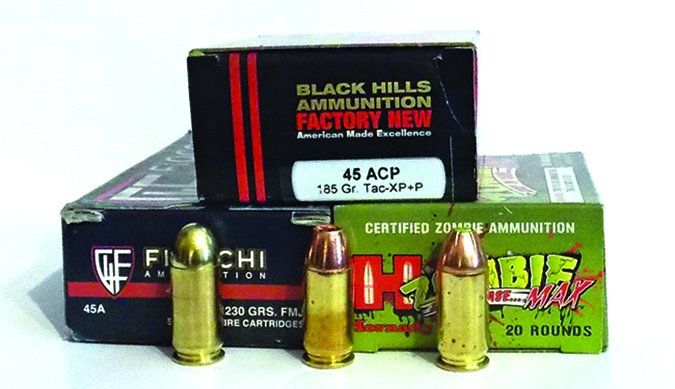
American Tactical Imports Firepower Xtreme Hybrid FXH-45 45 ACP, $600
GUN TESTS GRADE: D
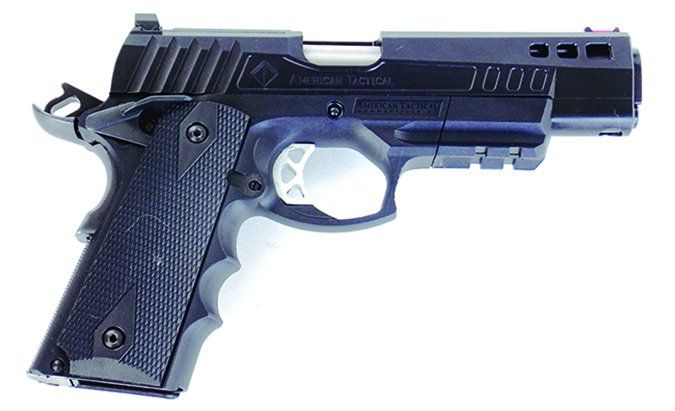
There isn’t much we can say about this pistol. The features are high tech, with much utility as a shooter and even for some competition. But we could not convince the pistol to fire without a trip back to the factory. Warranty response was timely.
| ACTION | Semi-auto single action |
| OVERALL LENGTH | 8.5 in. |
| OVERALL HEIGHT | 5.4 in. |
| MAX WIDTH | 1.5 in. |
| WEIGHT UNLOADED (w/ magazine) | 32 oz. |
| WEIGHT LOADED | 36.5 oz. |
| BARREL LENGTH | 5 in. |
| BARREL | 416 stainless steel, 1:16 twist |
| MAGAZINE | 8-rd. detachable box |
| SLIDE | 416 stainless steel; removable top plate |
| FRAME | Polymer, 2 aluminum inserts |
| FRAME FRONT STRAP HEIGHT | 2.6 in. |
| FRAME BACK STRAP HEIGHT | 3.2 in. |
| GRIPS | Black polymer |
| GRIP THICKNESS (max) | 1.3 in. |
| GRIP CIRCUMFERENCE (max) | 5.4 in. |
| SIGHTS | Fixed, interchangeable with Glock |
| TRIGGER PULL WEIGHT (SA) | 7.1 lbs. |
| TRIGGER SPAN (SA) | 2.5 in. |
| SAFETY | Slide lock safety, grip safety |
| WARRANTY | Limited lifetime |
| TELEPHONE | (800) 290-0065 |
| WEBSITE | AmericanTactical.us |
| MADE IN | South Carolina, USA |
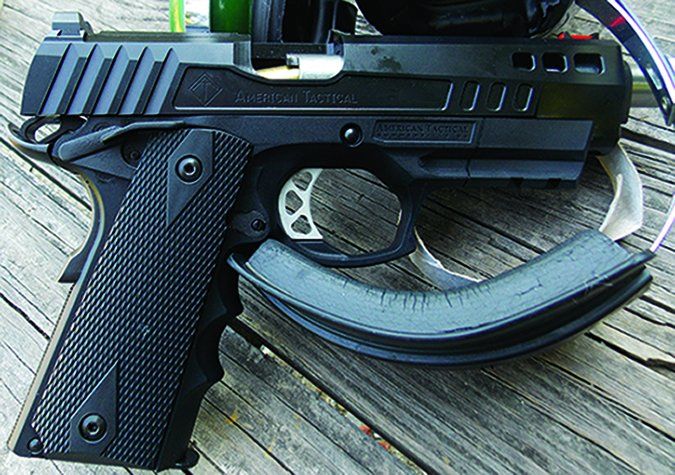
The first thing we noted is that the FXH Hybrid is delivered in a Gun Guard-brand hard case. Good choice. The pistol includes one Ammunition Storage Components magazine. The FXH departs considerably from previous experience with the 1911 and with other ATI pistols. The frame is polymer, with removable grips. The pivot tube and magazine release are typical of a 1911. The ambidextrous safety received high marks for its design and sharp functionality. The beavertail grip safety is a good design. The frame features three finger grooves, which are molded directly into the polymer grip. The trigger guard is elongated and allows for the use of gloves. The Picatinny rail is also molded directly into the frame.
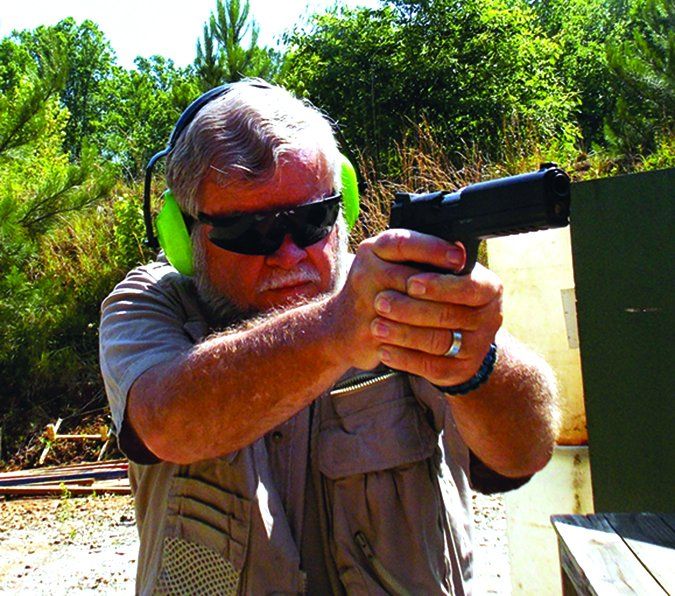
While we found the design interesting, and the originality of the frame precludes the pistol fitting into the 1911 holsters we had on hand. The other polymer-frame pistol fits both the DM Bullard inside-the-waistband holster and the Ted Blocker X16. The design of this pistol may make it difficult to find a holster for it.
The slide uses a standard barrel-bushing guide rod. The cocking serrations are large and allow for smooth handling. There are three indentations in the slide near the muzzle that may be used as forward cocking serrations. The slide features three ports on each side, even though the barrel is not ported.
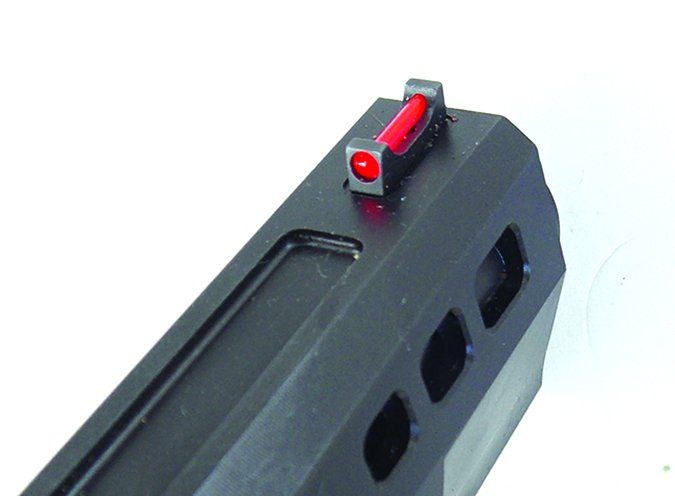
The FXH slide has a flat-top design. The rear end of the slide features a removable plate to allow the placing of an adapter mount for a red-dot scope. This is a big plus and a feature the other handguns did not have. The front sight features a fiber-optic insert for better visibility. The face of the rear sight is serrated, which was a nice addition. We really like the sight picture. According to ATI, the sights can be replaced with many aftermarket Glock sights that are available.
The pistol had many good features and showed promise — until we checked the trigger. When handling the unloaded pistol, and the slide was racked and the hammer cocked, we had difficulty pulling the trigger. One of the raters commented, “This is the heaviest 1911 trigger that I have ever tested.” He carefully made certain the grip safety was fully depressed and that the safety was off. The scale measured at an estimated 14 pounds of trigger press. Then, he could not make the hammer fall again. The pistol was racked repeatedly. To attempt to make it function again, we tried a gunsmithing trick known as the “poor man’s trigger job.” The hammer was held back, and the trigger was pressed a dozen times, with no change. This is supposed to burnish all of the working parts. After the “trigger job,” we tested the pull again, and the trigger began to break at 6.5 pounds. The pistol was then dry-fired a dozen times.
The next day at the range, the slide was racked and the pistol would not fire again. We unloaded the pistol and could not get the hammer to fall again. Finally, using the previous technique, a tester was able to get the hammer to drop. The pistol could not be fired for the test and evaluation at that time.
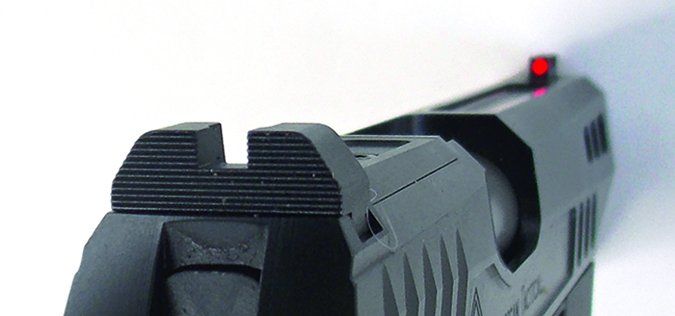
We planned to send the gun back to the factory under warranty to get it fixed, but gave the ATI pistol an initial F rating because the defect was so serious we could not even fire the pistol during testing. The next step was to return the pistol to the factory. The rater who contacted ATI’s customer service never mentioned this was a Gun Tests Gun, as is our policy. He contacted the company on a Tuesday, emails were traded, and a Fed Ex label was mailed to the rater. The pistol was shipped out on a Thursday, arrived at ATI the next day, and the rater had the pistol back the following Tuesday. Darned good service, we have to say.
The note in the box with the returned gun said that the trigger had been adjusted. The match trigger quite possibly had not been set properly from the factory. It had probably contacted the magazine release and failed to break the sear. Also, the note mentioned that the warranty work included a slide-stop upgrade, which is okay, but we had not detected a slide-stop problem during testing. The trigger now broke at 7.1 pounds, which is a little heavy, but we found it to be smooth enough. Still, the heavy trigger probably played into the less-than-stellar accuracy showing we detail below.
The returned pistol was loaded with the same mix of ammunition, the supplied magazine, and a mix of Mec-Gar and ACT MAG magazines. There were a total of five failures to cycle during the first 40 rounds of ammunition. After this break-in period, the pistol functioned normally. We really liked the sights. Felt recoil was not uncomfortable, despite the pistol’s light weight. In fact, we would say it was more comfortable that the EAA. Combat shooting was comparable to the other pistols. We then settled it into the benchrest to fire a number of groups with the same ammunition as previously fired in the other handguns. The ATI pistol was the least accurate tested; however, one bright spot was a single 2.25-inch group with the Hornady 185-grain load. Overall, the pistol did not deliver the accuracy we would have liked for the price.
Our Team Said: Considering the break-in malfunctions and substandard accuracy, we would not buy this pistol. We struggled over whether to maintain the gun’s original F grade or to revise the grade, and we chose the latter. We’ve described the gun’s initial lack of function, so the Gun Tests reader knows exactly what happened. But the factory warranty service was fast, and the gun did eventually start shooting. It just wasn’t that accurate. So we raised the grade to a D because of the presence of good features and good factory attention. But to make it crystal clear, none of our shooters would buy this test gun.
European American Armory Witness Elite 1911P Polymer 600347 45 ACP, $470
GUN TESTS GRADE: B-
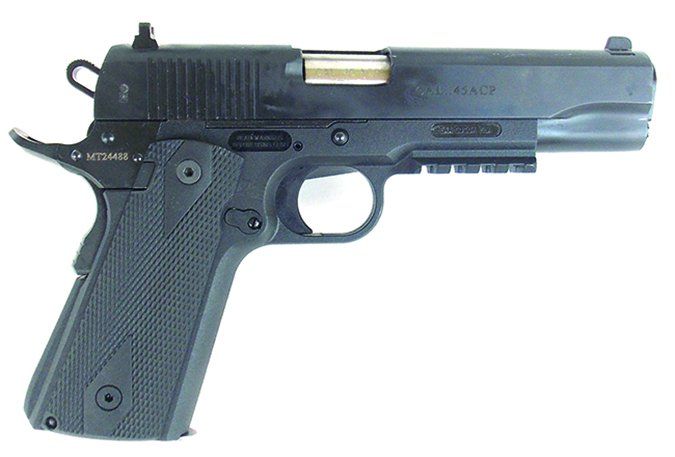
We liked the EAA Witness 1911P version. Fit and finish are good, and the pistol shoots better than its light weight would indicate. The feed reliability is good and so is the combat accuracy. It was the least accurate pistol off the bench rest on the first go-round, but that didn’t faze the raters who wanted a good carry gun. The flaw with the magazine latch, however, could have dire consequences.
| ACTION | Semi-auto single action |
| OVERALL LENGTH | 8.5 in. |
| OVERALL HEIGHT | 5.4 in. |
| MAX WIDTH | 1.5 in. |
| WEIGHT UNLOADED | 32 oz. |
| WEIGHT LOADED | 36.5 oz. |
| BARREL LENGTH | 5 in. |
| BARREL | Steel; 1:16 twist |
| MAGAZINE | 8-rd. detachable box |
| SLIDE | Steel |
| FRAME | Polymer single-stack grip; steel insert, flat mainspring housing; 4-slot picatinny rail; extended beavertail safety |
| FRAME FRONT STRAP HEIGHT | 2.6 in. |
| FRAME BACK STRAP HEIGHT | 3.2 in. |
| GRIPS | Black polymer |
| GRIP THICKNESS (max) | 1.3 in. |
| GRIP CIRCUMFERENCE (max) | 5.4 in. |
| SIGHTS | Fixed |
| TRIGGER PULL WEIGHT (SA) | 6.6 lbs. |
| TRIGGER SPAN (SA) | 2.5 in. |
| SAFETY | Slide lock, grip safety |
| WARRANTY | Lifetime |
| TELEPHONE | (321) 639-4842 |
| WEBSITE | EAAcorp.com |
| MADE IN | Tangfolio, Italy |
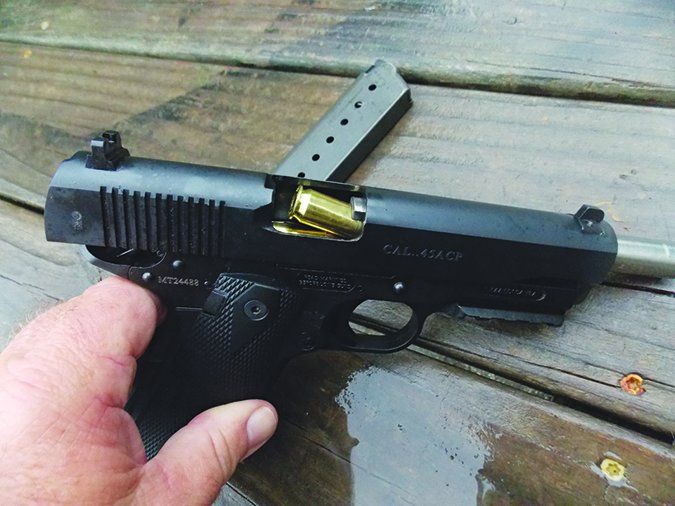
The Witness moniker was used in a line of popular CZ 75 clones. EAA chose to go with name recognition for this new polymer-frame handgun. This pistol is a rarity in the 1911 world because it is produced by Tanfoglio in Italy. The Witness 1911P is a 1911 clone with a more conventional appearance than that of the ATI FXH. This pistol is geared toward personal defense rather than competitive use. Which is fine since self defense is the most common role of the 1911, and a role that this pistol serves well. The frame isn’t made completely from polymer but features a steel insert that is serialized. The pistol features an unusual combination of a short trigger and a mainspring housing that isn’t completely flat or completely arched. The common rule in 1911 pistols is that a short trigger has an arched housing and a longer trigger has a flat housing. In this gun, the combination worked out well. In fast combat shooting, a short trigger with a good reset is preferred by many expert-level shooters.
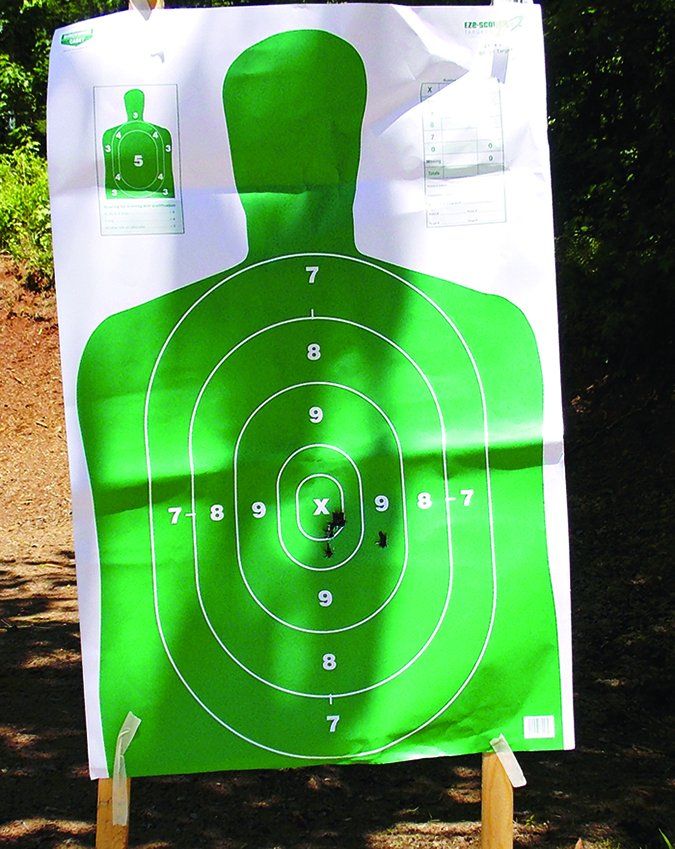
The pistol’s slide is well finished. The pistol does not have an ambidextrous safety. The beavertail grip safety is well designed and releases its hold on the trigger about halfway through its travel. The trigger releases cleanly at 6.6 pounds. The pistol is delivered with a single Mec-Gar magazine. The Witness 1911P has a standard GI guide rod. The recoil-spring plug is made of plastic. The Picatinny light rail includes a steel insert. The slide is conventional, with standard cocking serrations. The ejection port is lowered in a more modern fashion. The sights are well-designed combat sights. The front side is dovetailed in place, a good feature. The rear sight is high enough to allow racking the slide on a belt or other object if need be. The sight picture is excellent. Barrel and slide fit are good. The 1911P is tighter than the ATI pistol, we thought. Some effort is required to rack the slide. Fit in the rail-gun holsters we had on hand was good.
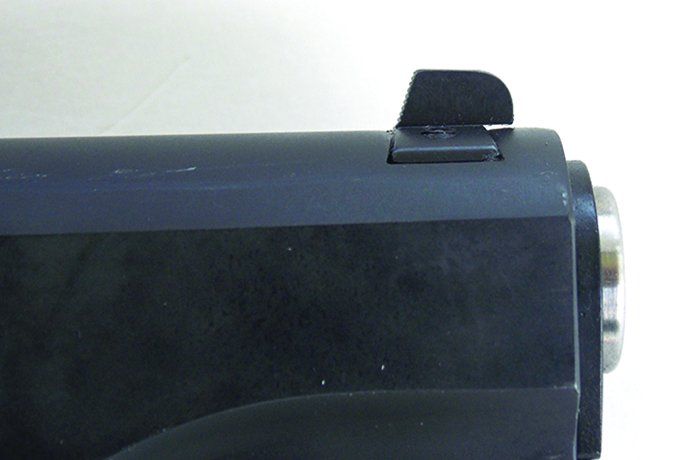
To evaluate the pistol, it was necessary to add a number of 1911 magazines to the test. We were not going to confuse the issue, so we used only magazines that had been previously tested. The pistol was well lubricated and the magazines were loaded with Fiocchi 230-grain full-metal-jacket ammunition. We began firing the pistol in combat drills at 5, 7, and 10 yards. There was a single failure to feed with the first magazine. There were no other failures during our testing. This is standard operating procedure with a tightly fitted 1911. However, we began to suffer several function problems that were traced to the supplied magazine. The first problem was that the magazine latch was releasing the magazine while firing. Some rounds simply stopped in the magazine well, and others fell out. The pistol fired reliably with Wilson Combat, Chip McCormick, and D&L Sports magazines during the test. GI-type, Colt, and Mec-Gar slipped the release. These magazines had previously been proven reliable in other handguns. It took a bit of extra ammunition to start the test over once we had placed aside the magazines that fell out of the magazine well. We were correct; the pistol did function correctly with some magazines, and not with others. This is not a good thing, and it limits the functionality of the pistol. When it comes to actually firing the pistol, it proved comfortable to fire, although it was the lightest 1911 we tested. While the long slide-recoil impulse isn’t as abrupt as it is with a Commander-sized 1911, the recoil is heavier because it is not a heavier steel-framed gun. The EAA Witness 1911P is a comfortable gun to fire compared to other 1911 pistols with a 4-inch barrel and light weight frame, our shooters said.
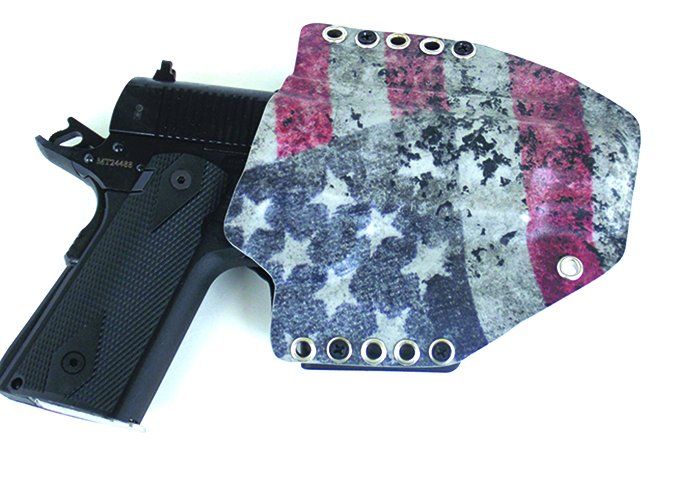
The combat-shooting groups were good. The pistol performed well once the magazine issue was resolved. One tester felt that the lighter EAA pistol was faster from leather than the RIA pistol or the Springfield. When it came to bench accuracy, we expected the pistol to perform on par with Commander-model 1911s.
The good, tight fit of the pistol and its smooth trigger gave us more than what we bargained for in accuracy. We used three different types of ammunition for the accuracy test. These included the Black Hills Ammunition 185-grain TAC +P, Fiocchi 230-grain FMJs, and Hornady 185-grain Zombie Max rounds. This gun’s best group of the day was a 2.1-inch cluster with the Black Hills Ammunition 185-grain TAC +P. Feed reliability was good. Accuracy was consistent.
Our Team Said: The pistol would be a great carry gun, with a Government Model sight radius and Commander-size lightweight feel. The combat accuracy was good and the bench accuracy was acceptable. The initial break-in malfunction did not trouble us because it was not repeated. The magazine issue must be resolved. At this point, a new magazine-release assembly or perhaps a new magazine-release spring are indicated. At present, the pistol is reliable only with certain magazines. We also would have preferred an ambidextrous safety.
Rock Island Armory Tactical 2011 w/Tru-Dot Sights 45 ACP, $590
GUN TESTS GRADE: A (Best Buy)
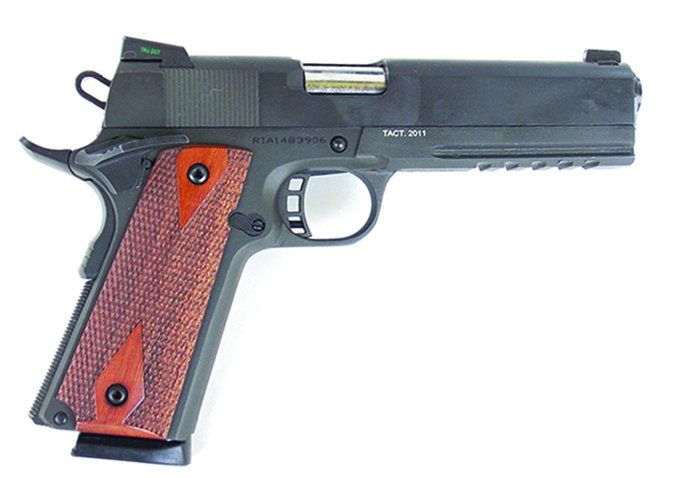
Has a lot of features for its modest price: Light rail, good barrel fitting, a set of TruDot night sights, a quality beavertail safety, and an ambidextrous slide-lock safety. Reliability and accuracy were very good. Exhibited the best trigger pull of the group.
| ACTION | Semi-auto single action |
| OVERALL LENGTH | 8.5 in. |
| OVERALL HEIGHT | 5.4 in. |
| MAX WIDTH | 1.5 in. |
| WEIGHT UNLOADED (w/ magazine) | 39 oz. |
| WEIGHT LOADED | 43.5 oz. |
| BARREL LENGTH | 5 in. |
| BARREL | Steel, 1:16 twist |
| MAGAZINE | 8-rd. detachable box |
| SLIDE | Parkerized steel |
| FRAME | Parkerized steel, slab-sided, square dust cover, 5-slot picatinny rail, beavertail |
| FRAME FRONT STRAP HEIGHT | 2.6 in. |
| FRAME BACK STRAP HEIGHT | 3.2 in. |
| GRIPS | Checkered wood |
| GRIP THICKNESS (max) | 1.3 in. |
| GRIP CIRCUMFERENCE (max) | 5.4 in. |
| SIGHTS | 2-dot adjustable TruDot rear; TrueDot single dot front |
| TRIGGER PULL WEIGHT (SA) | 4.5 lbs. |
| TRIGGER SPAN (SA) | 2.5 in. skeletonized trigger shoe |
| SAFETY | Ambidextrous slide lock safety, grip safety |
| WARRANTY | Limited lifetime |
| TELEPHONE | (775) 537-1444 |
| WEBSITE | Armscor.com |
| MADE IN | Marikina, Philippines |
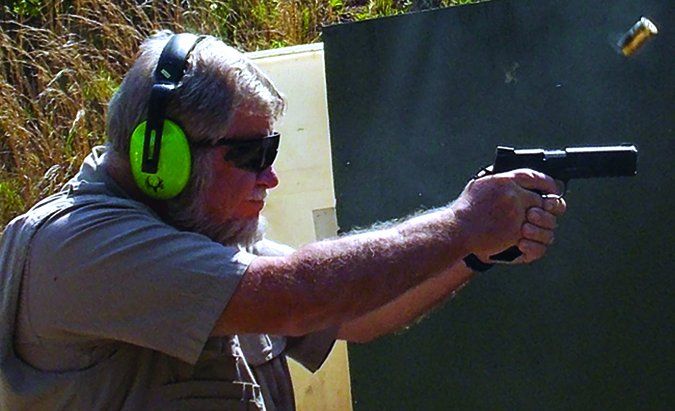
This was the price from Pennsylvania-based SarcoInc.com at the time of our test, and a recent check of the site showed they still had some supplies of this pistol in stock. The pistol is a monolithic steel-frame design that differs from previous Armscor models. The most noticeable difference between this handgun and the others is the weight. This is a true 5-inch barrel steel-framed pistol. We feel that the EAA Witness 1911P pistol is the carry gun, and the Rock Island Armory is the range gun. The pistol features the subdued matte Parkerized finish of a typical Rock Island pistol. The Picatinny rail is nicely integrated into the frame. However, this rail is longer on this pistol than the EAA or Springfield and will not fit into normal rail-gun holsters.
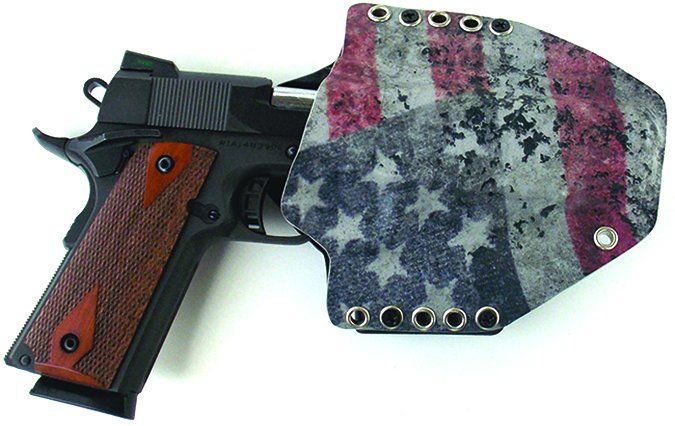
The sights are excellent all-around models, a TruDot self-illuminated iron sight combination that allows for clear sights in dim lighting. The sight picture during the range testing was excellent. The pistol features a flared ejection port. The barrel-to-slide fit is good, and the pistol features a standard barrel bushing paired with a full-length guide rod. The pistol includes a well-designed ambidextrous slide-lock safety that is supported by the right-hand grip panel. The beavertail grip safety is well designed and functions as intended, giving up its hold on the trigger about halfway into compression. The trigger is halfway between a long and short trigger and worked well for us. The trigger compression is a nice 4.5 pounds, the cleanest and lightest of any of the four pistols. A combination of front-strap serrations and a checkered mainspring housing provided excellent grip when firing.
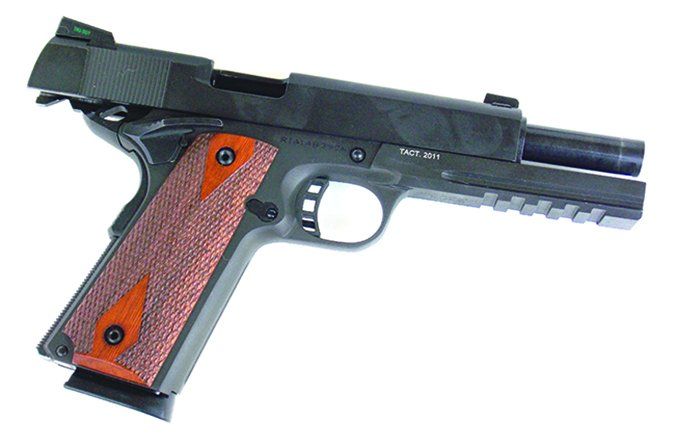
We began the combat drill with a well-lubricated pistol and Fiocchi FMJ ammunition as well as a good mix of magazines. The pistol sailed through 50 rounds without issue. During the accuracy stage, a single cartridge failed to load into battery, which is either a short cycle caused by shooter error or a break-in malfunction. It didn’t recur.
The RIA pistol was drawn from a belt-slide holster. Combat shooting was excellent, and the pistol was comfortable to fire.
We also found this heavy pistol was fast to target, and the front sight simply hung on the X ring as we controlled the pistol and got good hits. The pistol did well in accuracy testing, showing itself to be more consistent than the EAA. The Rock Island Tactical pistol was not as accurate as the Springfield Armory pistol, but we feel that the Armscor has plenty of accuracy for most uses. The best group of the day with the Armscor was a 1.9-inch-wide cluster shot with the Hornady Zombie Max ammo, the critical-defense bullet with a green tip.
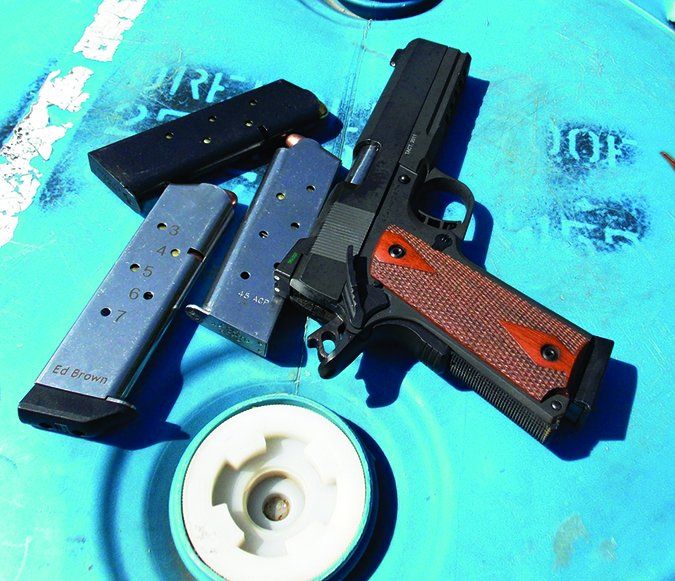
During firing, one tester came away with a moderately sore thumb. As most of us rest our thumb on the 1911 safety while firing, the sharp edges of the Rock Island slide-lock safety left a red line down the shooter’s thumb. This could be fixed by polishing and radiusing the edge, and that fix should be done because it could become increasingly uncomfortable with heavy loads.
Our Team Said: The Armscor Rock Island Armory Tactical pistol came out of the box running. The pistol looks good and has good features, including an ambidextrous safety that both the Springfield and the 1911P lacked. Accuracy wasn’t quite as good as the Springfield’s, but the modest price is appealing for this level of performance.
Springfield Armory Range Officer Operator PI9131L 45 ACP, $873
GUN TESTS GRADE: A-
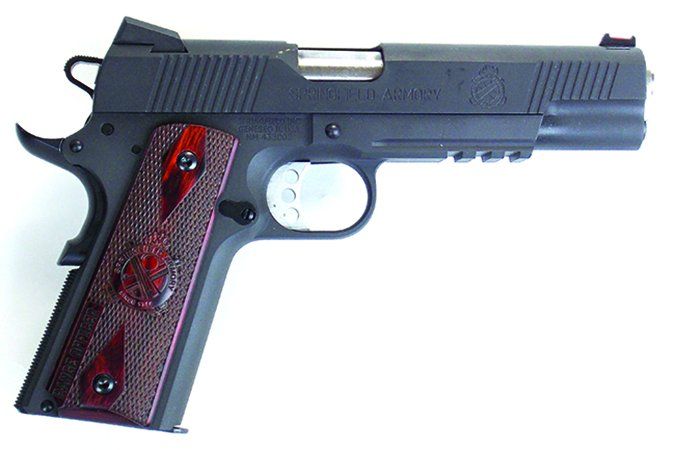
The Springfield Range Officer Operator exhibited good fit and finish. The Match Grade barrel lived up to its name. The Range Officer Operator is the most accurate pistol tested, but the pistol was only incrementally more accurate than the Rock Island Tactical pistol. Feed reliability was faultless.
| ACTION | Semi-auto single action |
| OVERALL LENGTH | 8.5 in. |
| OVERALL HEIGHT | 5.4 in. |
| MAX WIDTH | 1.5 in. |
| WEIGHT UNLOADED (w/ magazine) | 38 oz. |
| WEIGHT LOADED | 42.5 oz. |
| BARREL LENGTH | 5 in. |
| BARREL | Match-grade stainless steel, 1:16 twist, supported ramp |
| MAGAZINE | (2) 7-rd. blued |
| SLIDE | Parkerized carbon steel; GI recoil system |
| FRAME | Parkerized carbon steel, w/ 3-slot picatinny rail |
| FRAME FRONT STRAP HEIGHT | 2.6 in. |
| FRAME BACK STRAP HEIGHT | 3.2 in. |
| GRIPS | Checkered Cocobolo |
| GRIP THICKNESS (max) | 1.3 in. |
| GRIP CIRCUMFERENCE (max) | 5.4 in. |
| SIGHTS | Fixed Novak rear; fiber-optic front |
| TRIGGER PULL WEIGHT (SA) | 6.5 lbs. |
| TRIGGER SPAN (SA) | 2.5 in. |
| SAFETY | Slide lock safety, grip safety |
| WARRANTY | Limited lifetime |
| TELEPHONE | (800) 680-6866 |
| WEBSITE | Springfield-Armory.com |
| MADE IN | Brazil, finished in USA |
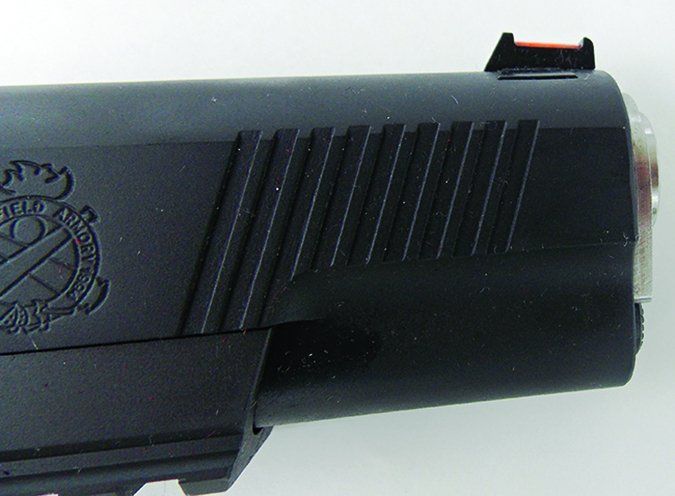
This was the price from CheaperThanDirt.com at the time of our test. Springfield has used the Range Officer as a designation for its “value line” of 1911 handguns for many years now. The primary difference between the Range Officer guns and the company’s high-end pistols is the finish. The Range Officer model features a nice Parkerized finish, not a high-polish look. The pistol’s finish isn’t the blue or two-tone of the Springfield Operator. The lack of an ambidextrous safety is also a cost-cutting measure. The Range Officer Operator is, on average, about $240 dollars less than the full-blown Operator.
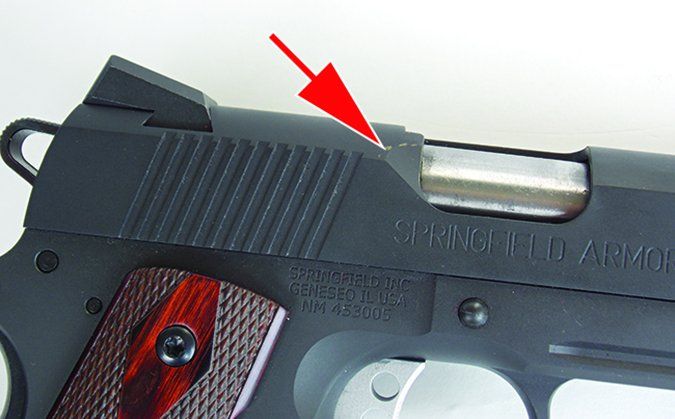
Springfield advertises the Range Officer line as having a match-grade barrel. Our accuracy testing indicates that the barrel and bushing are well fitted. The Springfield Range Officer Operator features a Picatinny light rail. The slide is similar to the Loaded Model, with Novak white-dot rear sights and a fiber-optic front sight. The pistol features a scalloped ejection port, a lightweight hammer, a target trigger, and a well-designed beavertail safety. What it does not have is an ambidextrous safety. This could be a deal-breaker for the left-handed shooter.

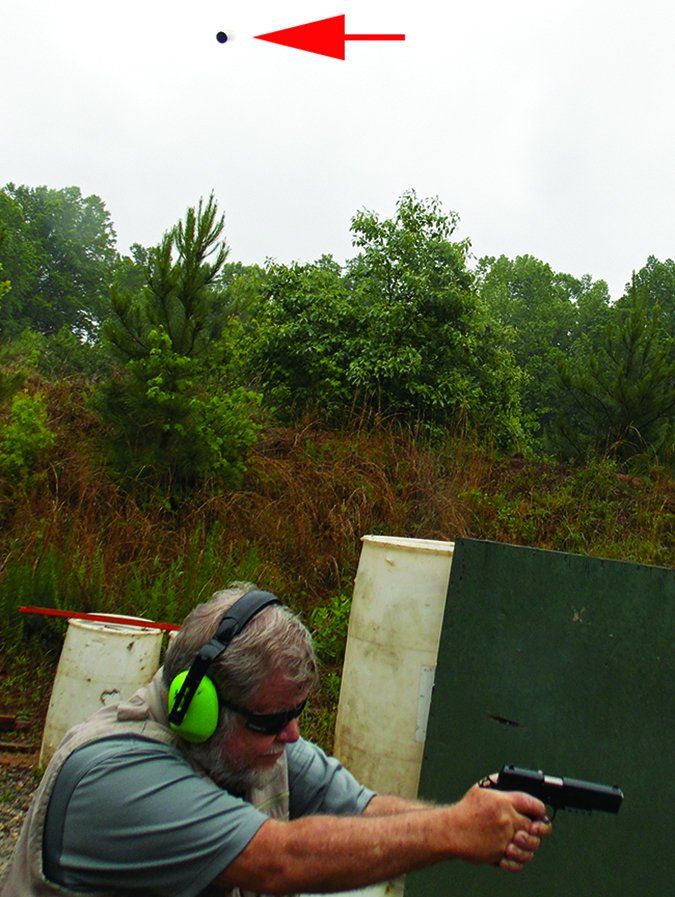
Trigger compression is clean at 6.5 pounds. Accuracy and reliability should be the same as other versions tested, and we were not disappointed. The Springfield was lubricated and then fired with the same Fiocchi FMJ loads that were used to test the other pistols. Initial firing was at 5, 7, and 10 yards. The pistol fired 50 rounds of this 230-grain FMJ ammunition without a single failure to feed, chamber, fire, or eject. The fiber-optic front sight came on target quickly with good sight acquisition. The pistol did not display any break-in malfunctions. Combat accuracy was good. It only makes sense that the heavier guns were more accurate and easy to shoot on the firing range. The RIA weighs 1 ounce more than the Springfield. As far as control goes, the Rock Island Armory pistol was more comfortable to fire, as far as momentum goes, but this is difficult to describe in print. In bench shooting, the Springfield’s excellent barrel fitting and tight barrel bushing contributed to practical accuracy. We would have liked a lighter trigger action, but the 6.5-pound trigger pull was smooth. The best effort was a five-shot group with the Black Hills TAC-P at 1.7 inches. However, the Hornady Zombie Max equaled this and the average for each load was within 0.1 inch of the other, an unusual showing. The shooter was firing to the best of his ability, and possibly the firearm and ammunition were capable of better accuracy.

Our Team Said: The Springfield Range Officer Operator is an excellent pistol, giving Springfield fans good performance at a fair price. The Springfield was the most accurate pistol tested. The lack of an ambidextrous safety is more important to some than others, and the Springfield did not suffer a stoppage of any type. The pistol may have earned an A+, save for the lack of an ambidextrous safety. So if that feature doesn’t matter to you, then go ahead and mark up your copy of the magazine with our compliments.
Written and photographed by R.K. Campbell, using evaluations from Gun Tests team testers.





























I used to look at pistols listed by manufacturer. Just click on one and the Gun Test came up. I cannot find anything on the web site like that. I also had trouble signing on and paying my bill. For a while I could not get the field to accept all of the digits of my subscriber number. 850121001554. I’m not sure if it’s me or the website but it doesn’t seem easy or intuitive to use. Regardless, I paid for another year.